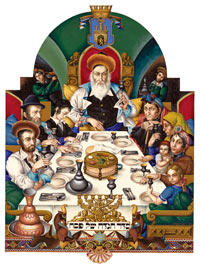 The central tradition of Passover, which starts tonight, is for families to gather together for a festive meal called a Seder (“Order”) and read about the Exodus from Egypt from a book called the Haggadah (“Telling”). First compiled in the 1st and 2nd centuries C.E., at a high level the Haggadah is a fifteen-step manual for conducting a Seder. Some of the sections involve food rituals, others prayer, but the longest recounts the story of the Exodus from Egypt and the meaning of the miracles that took place.
The central tradition of Passover, which starts tonight, is for families to gather together for a festive meal called a Seder (“Order”) and read about the Exodus from Egypt from a book called the Haggadah (“Telling”). First compiled in the 1st and 2nd centuries C.E., at a high level the Haggadah is a fifteen-step manual for conducting a Seder. Some of the sections involve food rituals, others prayer, but the longest recounts the story of the Exodus from Egypt and the meaning of the miracles that took place.
The Haggadah takes an interesting narrative approach. First of all, it is a highly personalized account.
We were slaves to Pharoah in Egypt, and the Lord our God brought us out of there with a strong hand and an outstretched arm. And if the Holy One, Blessed be He, had not taken our fathers out of Egypt, then we and our children, and the children of our children would still be enslaved to Pharoah in Egypt.
This introduction sets the tone for all that is to come: we’re not supposed to just sit around reading old Bible stories. We’re meant to see the protagonists as more than just our fathers, but as ourselves! “An Aramean ensalved my father,” “we cried out to the Lord, God of our fathers,” “the Lord heard our voices,” “the Lord lifted us out of Egypt” — at every opportunity the Haggadah uses the first person plural to bring us into the story. These things didn’t happen to them, the Children of Israel — they happened to us! Towards the end of this section my favorite part of the whole Haggadah makes this point clear:
In every generation a person is obligated to see himself as though he had gone out from Egypt… It was not only our fathers alone whom the Holy One, Blessed be He, delivered, but also we were delivered with them.
You can only imagine how this worked on my mind as an ancestor-obsessed child…
And involving the children amongst the Seder participants is the other key narrative distinction of the Haggadah. The early parts of the Seder include a lot of unusual rituals designed to pique their curiosity, culminating with the youngest child present asking, “Why is this night different from all other nights?” and the famous Four Questions about those odd rituals. These scripted questions are meant to set the tone for children to ask unscripted questions throughout the rest of the Seder. As the Haggadah explains, the more we discuss the Exodus from Egypt, the more praiseworthy we are — and this extends to children as well.
Children are again explicitly involved during the section about the Four Sons: the wise one, the wicked one, the simple one, and the one who doesn’t know how to ask. Children are meant to emulate the wise one, who asks for all the details about the holiday, and not the wicked one, who asks, “What does this worship mean to you?” But parents are responsible for all of them, and the Haggadah provides answers for each, including rebuking the wicked one for divorcing himself from his own history. All of those “we,” “us”, “our” pronouns throughout the Haggadah only work if parents raise their children to know and value their background.
Whatever your family’s background, there is much to learn from this ancient text when it comes to passing down family history — how to interest our children in remote events, encourage them to ask questions, take the time to answer them in detail, and most of all, personalize the history so it has significance for them. The Haggadah urges us to make this conversation ongoing, but Passover ensures that at least once every year all the generations come together to ask questions and share answers about how we came to be who we are. Knowledge of family history is meaningless without doing the work to pass it on in a meaningful way.
Happy Passover to those who celebrate!
 Follow
Follow